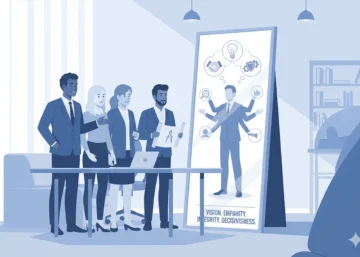Hallett Leadership, as a rule, doesn’t give out prescriptions for achieving high performance leadership… but there is one stake we have placed firmly in the ground, and it is at the center of our training & development territory.
What is it, exactly?
There is a missing piece inhibiting most organizations from realizing their potential. It revolves around the principle that to be a truly high-performance organization, high performance must exist and be reinforced at all levels of the organization. While many companies drive high performance leadership in their senior ranks, high performance is not a priority in the middle and lower tiers of those organizations. This is the Missing Piece.
In light of the missing piece, and our training and coaching services that are committed to filling in that missing piece, today we’re going to make the case for investing in manager training & development by describing four major benefits of effective middle management training.
When we undertake a training program to help a client fill in their missing piece, and begin the process of developing middle managers from every department into a collaborative cohort of high performance leaders, we begin by offering the group a placeholder vision to pursue:
To achieve an open, collaborative culture where creativity and innovation thrive.
Following this vision, the group can properly begin its quest to break down organizational silos, train managers to generate results through their teams – instead of shouldering all the work themselves – and empower team members to share personal responsibility for overall results.
Success in this sort of training and development process, in reality, results in a profoundly transformed organizational culture where high performance leadership is the new normal. Those organizations that carry it out can reasonably expect to achieve the following four benefits:
Increased Efficiency
A leadership training program carried out in alignment with the vision introduced at the top of this article puts people and formerly rival departments together to collaborate and create new relationships, processes and company structures. People who dialogue and collaborate across multiple departments are capable of innovating new processes, procedures and workflows that reduce friction and expedite robust communication. The result is increased efficiency.
Increased Competitiveness
Aligned people who collaborate with each other and create new and improved working processes are greasing the gears of organizational machinery, and arranging new and improved ways for identifying products and projects and bringing them to fruition. The result is increased competitiveness in the marketplace.
Increased competitiveness operates as a sort of positive feedback loop. Already-aligned and collaborative work teams taste victories that continue to encourage collaborative, creative behavior, leading to more victories.
Increased Innovation
Your open, collaborative, and creative culture now boasts a workforce of aligned people who are excited to come to work each day. This is precisely the sort of culture from which innovations emanate. Products and services that no one ever thought of before; products and services which upon being introduced to the market, customers and clients can no longer do without. This is innovation. A phenomenon possible, when implemented through the formula we described in the vision above.
Increased Retention
There’s the apocryphal tale of the CEO and COO sitting together at the end of a long day, having reviewed a proposal from a well-known leadership development consultant. The program in the proposal represents a substantial financial and time investment. The CEO says to the COO:
“What if we train our people and they leave to pursue more lucrative opportunities elsewhere?
To which the COO replies:
“What if we don’t train our people and they stay?”
It is understandable for any senior leaders to fear losing people after having invested in their development, having made them more attractive to industry competitors. Competitors allegedly lurk in the shadows to peel off top-level talent.
What we have found in our nearly 20 years of facilitating the world’s premier leadership program is, in practice, quite the opposite. Instead of grabbing at opportunities to take their new skills elsewhere, program participants develop a stronger sense of loyalty for the companies that make an investment in them. Therefore, investing in your people is one of the finest and most direct means of expressing care and regard for them. Bottom line: one of the best ways of increasing your retention rate is to invest in your managers’ training and development.
Increased retention is valuable on its own – yet other ancillary benefits also ensue. Companies whose employees desire to remain tend to exhibit cultures that are attractive to outsiders. That is, as companies develop into open and collaborative cultures where creativity and innovation thrive, they develop into some of the most desirable places to work.
The image that comes to mind is of your employees being contacted fairly regularly on LinkedIn from industry friends who are “checking in” about any in-house intelligence regarding upcoming work opportunities.
Conclusion
Openness and collaboration lead to increases in efficiency, which in turn foster a greater competitive edge. These improvements, supported by teams collaborating of their own volition, reach a critical threshold where teams begin innovating at a higher level, allowing them to disrupt themselves before others do. People want to be part of that environment, so retention is no longer an issue. It all begins with a vision that guides effective middle management training and development, filling in the missing piece of the organization. This unlocks the potential and capabilities of your people, and aligns and coordinates activities so that your company is elevated to a whole new paradigm.
Best of luck, and please feel free to reach out if you would like to inquire about what such a paradigm shift could look like at your company.





